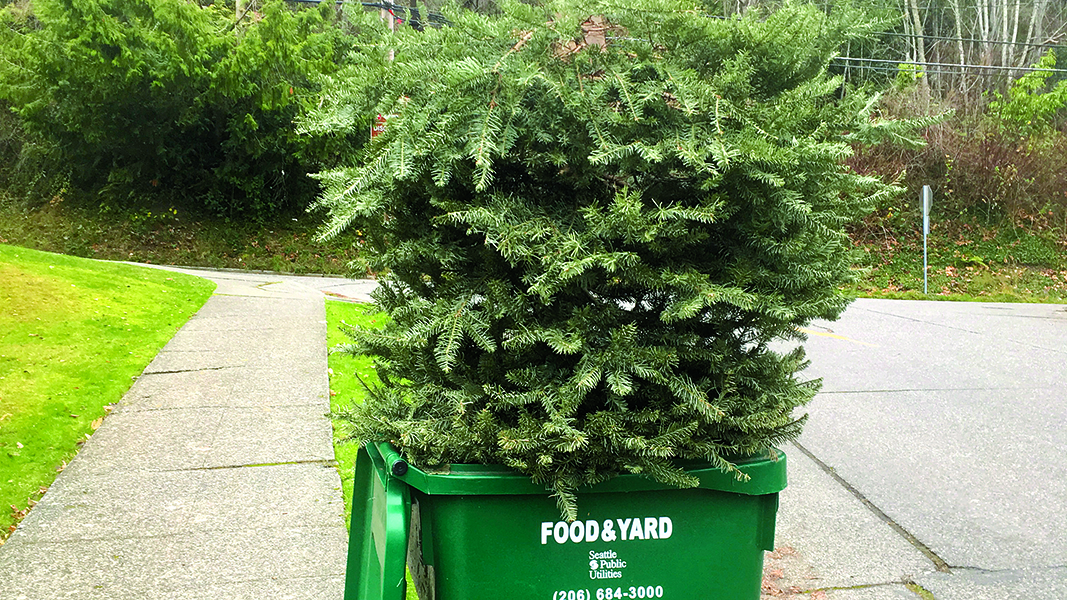
Sally Brown
The joy of the holiday is followed by that sad time of year when those Nobles, Grands, and Pines are lining the curbs waiting for pick up. These fine trees helped get us through the solstice with their twinkling lights, shiny ornaments and wonderful smell. Now they are all very dead, never to grow past that 7-foot mark, never to live in an actual forest. Should we feel guilty about these dead trees? Should we turn to fake trees in an attempt to spare these fallen soldiers? Is artificial a better alternative for the environment if not your living room? Some information can help counter the emotions that threaten to guide this critical decision.
First it is important to realize that the trees that grace our living rooms are grown almost exclusively on farms. All but 2 percent of the Christmas trees sold are planted and grown for the specific purpose of gracing our homes. They are a crop, just like lettuce and soybeans. Nationally we have about 350,000 acres devoted to growing Christmas trees at a seeding rate of 2,000 trees/acre. About 30 million trees were harvested for sale in 2012. The tree farms are located primarily in Oregon (5.2 million), North Carolina (3.5 million), Michigan (3 million), Pennsylvania (2.3 million) and Washington (1.5) million.

More exotic uses for recycled Christmas trees include placing them on beaches to reduce erosion, or in lakes and ponds to provide habitat for fish. Photo by Sally Brown
These farms bring in a lot of income — $90 million in Oregon alone. So Christmas trees are grown for money. And as with any business, one can expect a certain amount of waste. But unlike other crops, these trees are not meant to be eaten. These trees are grown to be discarded. That means we can look at both the carbon/environmental impacts of growing the trees and of throwing them away.
Compared with growing corn, growing Christmas trees is an environmentally friendly practice. Oregon State University extension has a number of publications on Christmas trees, including a nutrient management guide. It turns out that trees are not a very hungry crop. In fact, when the site is prepared to plant, the one nutrient left out is nitrogen. Too much nitrogen makes the grass around the trees outgrow and stifle the trees. Nitrogen is only added when trees are about 3-feet tall and again before harvest. This is the nutrient that helps make those needles green and no one wants a tree with yellow needles.
The extension bulletin mentions organic sources of fertility including municipal biosolids as the fertilizer option of choice. The trees are typically grown in a 7 to 10 year rotation with no tillage in between planting and harvest. In other words, with the trees you have a crop that builds soil carbon, requires minimal nutrients, and is responsive when those nutrients are provided in the form of recycled organics.
Better yet, the discarded trees can be recycled and used to produce the next crop for holiday joy. Dead Christmas trees have many potential end uses and composting is high on the list. Just about all municipalities that offer yard trimmings collection or drop off will accept them. In certain cases, collection options are limited but drop off options are typically provided. Trees can be hard to compost on your own. The wax in the needles requires the higher temperatures of a large composting facility.
Other than composting, the trees can be chipped and applied as mulch. More exotic uses include placing dead trees on beaches to reduce erosion and putting them into lakes and ponds where they provide habitat for fish. In other words, they can go from decorating your living room to being the living room for schools of bass and perch. In short, there are many environmental options for these dead trees. Even throwing a dead tree into the woods to decompose is okay. Real Christmas trees can be part of a cycle, that same cycle of seasonal growth and decay.
The Artificial Option
What if you decide to go artificial? As of 2017, about 81 percent of the households in the U.S. made that choice, according to the American Christmas Tree Association (ACTA), the artificial tree trade group. In fact, the artificial tree industry argues that in addition to making less of a mess, the fake trees are also environmentally friendly. Artificial trees (here I am talking about the green kind, not necessarily the silver ones like my grandmother used to have) are typically made from polyvinyl chloride (PVC) in the Pearl River delta region of China. They also have steel and aluminum. The raw materials required to manufacture a tree are about the same as those required to make a chair for your patio, noted an article last December in the Los Angeles Times.
In theory these PVC trees can be recycled. I decided to call the recycling hotline here in Seattle. We can recycle most everything, so I figured this was as good a place to ask as any. The short response to my question was “no.” Reading up on this I also found out that lead had been used as a stabilizer for artificial trees. The scandal a while back about lead-contaminated children’s toys from China was also the case for artificial trees from China. So if you’ve had an artificial tree for a while, you might want to consider either getting a new one or going real.
If you keep your fake tree long enough, the environmental costs of it go down to the point where it is on par with the real McCoy. According to a study commissioned for ACTA, this can be anywhere from 6 to 10 years. Realize that the funding for the study was from an organization with a vested interest and that the study can be found as a report rather than in the peer review literature. Unlike live Christmas trees, artificial ones are part of a line, not a cycle. That line travels from a delta in China to a store and then a living room and then a landfill. The best diversion that one can hope for is a stop at a second hand store and another living room before the landfill.
What this all means is that I really should stop feeling terrible about all those trees that are lining the sidewalks after the holiday. Real Christmas trees are better for the soil, environment and the U.S. economy than the artificial ones. If we ensure they are put to a good second use, these trees can be enjoyed without regret.
Sally Brown is a Research Associate Professor at the University of Washington in Seattle and a member of BioCycle’s Editorial Board.













